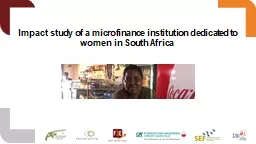

Africa Context A study launched in 2020 at the initiative of SEF Small Enterprise Foundation and SIDI Solidarité Internationale pour le Développement et lInvestissement Accompanied and cofinanced by the ID: 931769
Download Presentation The PPT/PDF document "Impact study of a microfinance institut..." is the property of its rightful owner. Permission is granted to download and print the materials on this web site for personal, non-commercial use only, and to display it on your personal computer provided you do not modify the materials and that you retain all copyright notices contained in the materials. By downloading content from our website, you accept the terms of this agreement.
Slide1
Impact study of a microfinance institution dedicated to women in South Africa
Slide2Context
A
study
launched
in 2020
at
the initiative of SEF (Small Enterprise
Foundation
) and SIDI (Solidarité Internationale pour le Développement et l'Investissement
)
Accompanied and co-financed by the
F3E
Co-financed by the
Grameen
Crédit
Agricole
Foundation (FGCA
)
Commissioned to Reciprocity and ALESOPI Consulting
Slide3Objectives
For SIDI
&
GCA
Foundation
:
Testing our respective impact models
Better understand the socio-economic effects of an MFI on its final beneficiaries and assess whether the effects of
SEF
activities contribute to the reduction of gender inequalities
Disseminate the results within
our respective
networks of partners
For SEF
:
Determine whether their financial services offer has contributed to the improvement of the economic and social situation of their clients
Identify areas of improvement for its operational work
Value client data collected through the
PPI
tool
Slide4Methodology
Slide5Slide6Slide7Results
Slide8SIDI & FGCA : What we learned
from
this
study
?
Slide9Lessons from the study as an investor
Detailed illustration of the changes observed in the final beneficiaries, which helps to improve our knowledge of the field and to promote impact investing
Interest in joining forces between investors: very positive collaboration
Need
to encourage, as an investor, the conduct of such studies among partners who do not have sufficient financial and human resources to document their social mission
Need
to involve partners from the beginning in the definition of needs: importance of finding a mutual interest in this type of exercise (investor on one side and partners on the other)
Interest in using pragmatic methods, which are based as much as possible on data already available in the organization and which leave an important place to qualitative
analyses
Limits of the multiplication of the objects of analysis
Slide10Lessons from the study for the sector
Three main lessons to remember
:
Microfinance improves the daily lives and resilience of clients: loans are used by clients for income-generating activities and for consumer goods that improve household equipment.
Microfinance can also have negative effects that should be addressed:
Social relations within a group of clients may deteriorate if one member of the group is late or defaults on her payments.
Negative effects can occur within the household when the husband discovers that his wife is
a SEF client
and that she has been hiding it from them.
This study is a reminder of the need to standardize impact measurement within the microfinance sector:
Efforts to document impact must be continued to avoid impact-washing
.
It is necessary to build a framework for measuring impact and to be able to compare impact indicators in order to establish benchmarks.